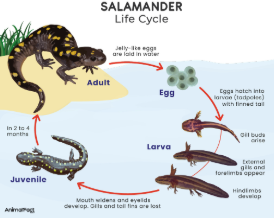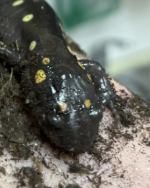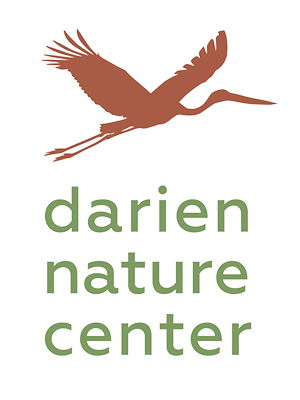
The Secret World of Salamanders
by Molly Robertson, Program Director
The spotted salamander is one of my favorite animals. I have only seen these elusive native Connecticut animals a few times in the wild. Salamanders are ectotherms (cold-blooded), anamniotic (lay their eggs in water), four-limbed vertebrate animals. Spotted salamanders have a beautiful blueish-black body with yellow spots. Salamanders are part of the amphibian family, which includes frogs and newts. Amphibian comes from the Greek word
amphibious,
which means "to live a double life." After hatching from an egg in a vernal pool, amphibians live in the water as tadpoles, breathing through gills. Most then undergo an amazing metamorphosis, growing legs and lungs to become air-breathing adults, hence the “double life.” The small red-back salamanders we find on walks with our classes are lungless and breathe
only through their skin!
Larger “mole” salamanders, like Connecticut's spotted and marbled salamanders, have lungs to breathe, but like all salamanders, they use their skin as a secondary respiratory interface. We will unlikely ever find a spotted salamander in Cherry Lawn Park as they must lay their eggs in vernal pools (vernal means "spring," as vernal pools are temporary bodies of water that form every spring). Vernal pools dry up by early summer and are an essential habitat for spotted salamanders. Wondering why? Since vernal pools are temporary, they do not have any predatory fish in them, making them a safe spot to lay eggs. In May, our educators meet up with all Darien second graders in Selleck's Woods, and I always call attention to the vernal pools and their critical role in the salamander life cycle.
When we find a salamander at the nature center, we only hold it for a very short period and always with dirt on our hands (which is half the fun!) so as not to damage its delicate, porous skin. Air and liquids can pass through salamander skin, making it very susceptible to any bug spray or sunblock on our hands as well as pollution. With their complex reproductive needs and permeable skin, salamanders are considered an "indicator species" for the planet’s health. Sadly, there has been a dramatic decline in salamander populations around the world.

Salamanders have an astonishing ability to regenerate limbs, tails, and vital organs like the heart, spinal cords, and jaws without scarring! Scientists are studying salamanders' regenerative powers to advance medicine.
As I hope for a world where all living things are treasured and respected, I think of the humble salamander. Gentle, quiet, hidden away from the world, yet possessing a superpower no human has, that of regeneration. I want these amazing little animals to always have an essential role on our planet. Come to the Nature Center, get your hands dirty, and meet our spotted salamander, Pebbles. Let's protect these charming creatures so salamanders are around for all future generations.

